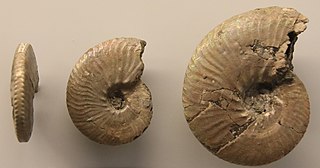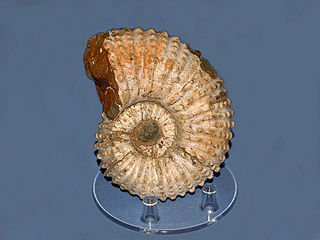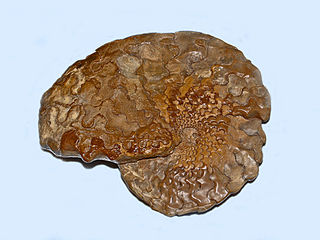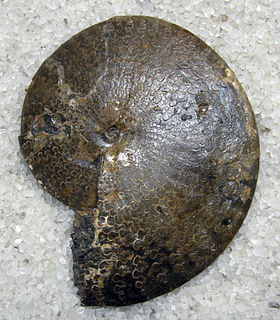
Euhoplites is an extinct ammonoid cephalopod from the Lower Cretaceous, characterized by strongly ribbed, more or less evolute, compressed to inflated shells with flat or concave ribs, typically with a deep narrow groove running down the middle. In some, ribs seem to zigzag between umbilical tubercles and parallel ventrolateral clavi. In others the ribs are flexuous and curve forward from the umbilical shoulder and lap onto either side of the venter.

Acanthohoplites is an extinct genus of ammonites in the family Parahoplitidae that lived in the Aptian and Early Albian stages of the Early Cretaceous.
Aioloceras is an ammonite, order Ammonitida, from near the end of the Early Cretaceous. The shell is compressed with the outer whorl covering much of the previous. Sides are slightly convex, converge toward a narrowly ached venter. Inner whorls have sharp falcoid ribs, outer are smooth. Umbilical tubercles are lacking. Similar related forms include Neosaynella and Cleoniceras.

Anahoplites is a genus of rather involute, compressed hoplitid ammonites with flat sides, narrow flat or grooved venters, and flexious ribs or striae arising from weak umbilicle tubercles that end in fine dense ventrolateral nodes. The elements of their sutures are short, wide and jaggedy. Specimens of Annahoplites have diameters typically in the range of 4–6 centimetres (1.6–2.4 in) although some with diameters of as much as 19 centimetres (7.5 in) have been reported. The genus lived during the Cretaceous, from the Middle to the late Albian.
Anisoceratidae is an extinct family of heteromorph ammonites which belong to the Ancyloceratina superfamily Turrilitoidea. Members of the family range is from the lower Albian to the upper Turonian. The family is possibly derived from a member of the Hamitidae.

Douvilleiceras is a genus of ammonites from the Middle to Late Cretaceous. Its fossils have been found worldwide, in Africa, Asia, Europe, and North and South America.

Tissotiidae is a family of ammonites (Ammonitina) belonging to the Acanthoceratoidea.
Morrowites, named by Cobban and Hook, 1983, is a moderate to large-sized ammonite with quadrangular to depressed whorls, broadly rounded to depressed venter, low ribs, umbilical and inner and outer ventrolateral tubercles and smooth early whorls except for occasional ribs along weak constrictions. The suture is moderately simple and has an unusually broad bifid first lateral lobe. It is so far restricted to the Lower Turonian stage, in the mid Cretaceous.

Mammites is a Late Cretaceous ammonite genus included in the acanthoceratoidean family, Acanthoceratidae, and the type genus for the subfamily Mammitinae. Mammites was named by Laube and Bruder in 1887.
Pachyceratidae is a family of Perisphinctoidean ammonites from the upper Middle - and lower Upper Jurassic. Genera within the Pachyceratidae have shells that are in general moderately involte but with most of the inner whorls exposed; whorl sections subquadrate to subtrapezoidal, with rounded venter. Ribbing is strong, in some sharp. Primary ribs typically branch above mid flanks into twos, threes, and even fours.

The Hoplitidae is a family of Cretaceous ammonites that lived during the middle of the period from the late Aptian to the Cenomanian. They are part of the superfamily Hoplitoidea.
Hecticoceras is an ammonite genus belonging to the haploceratoid family Oppeliidae, that lived during the Middle and Late Jurassic, from the Callovian. Hecticoceras may be seen as a series of some nine subgenera, beginning with the lower Callovian H. (Hecticoceras) and H. (Hecticoceratoides) and ending with the lower Oxfordian H. (Pseudobrightia) and H. (Eochetoceras). Hecticocerassensu lato and Prohecticoceras from the underlying Bathonian form the oppeliid subfamily, Hecticoceratinae.

Engonoceratidae is a family of typically compressed, more or less flat sided and involute ammonites from the mid Cretaceous belonging to the Hoplitoidea. shells have flat sided outer rims ( venters), at least in some stage. Single or branching irregular ribs and variably placed tubercles may occur. Sutures have numerous auxiliary and adventive elements of similar form, in general radially arranged. Forwardly divergent saddles tend to be simple, without subdivision. Lobes, pointing apically, may be simple and undivided or may be frilled with short irregular serrations.
Brancoceratidae is a family of acanthoceratoid ammonites from the middle of the Cretaceous, recognized by their commonly evolute shells with round, oval, or quadrate whorls, strong ribs, usual ventral keels, and at least, umblical tubercles. The family is thought to be derived from the Desmoceratidae (Desmoceratoidea), perhaps from Silesitoides or some allied genus.
Leymeriellidae is a family of Lower Cretaceous ammonites comprising rather small forms distinguished from Hoplitidae by their flattened and grooved ribs and virtual absence of umbilical tubercles. The family is derived from the Desmoceratidae. Leymeriella schrammeni anterior has evolved from Desmoceras keilhacki keilhacki.
Neocardioceras is a genus of evolute acanthoceratid ammonites from the uppermost Cenomanian, Upper Cretaceous, of Europe, western U.S. and Brazil.
Euomphaloceras is an early Upper Cretaceous ammonite genus,, included in the Acanthoceratinae until established as the type genus for the Euomphaloceratinae by Cooper, 1978.
Flickiidae is a family of dwarf ammonites with little ornament and very simples sutures known from small pyritic specimens found in middle Cretaceous deposits. Inclusion in the Acanthoceratoidea is tentative.
Otohoplites is a genus of ammonite that lived in the Early Albian age and whose fossils were found in Svalbard, Denmark, England, France, Austria, Poland, Russia and Kazakhstan. It has evolved from Hemisonneratia and gave rise to the genus Hoplites. Shells belonging to this genera are rather inflated to compressed and have zigzagging, or looped ribs that end in oblique ventrolateral clavi. Usually, ribs are zigzagging through venter. Macroconchs have a smooth body chamber and rounded venter.
Funiferites is genus of ammonite that lived during end of middle and in upper Callovian stage of middle Jurassic.








